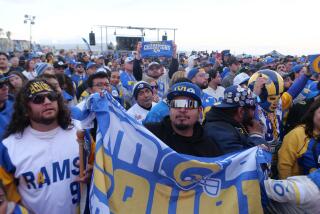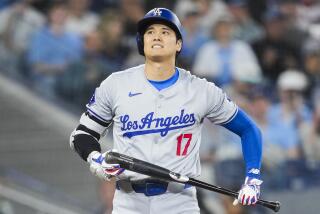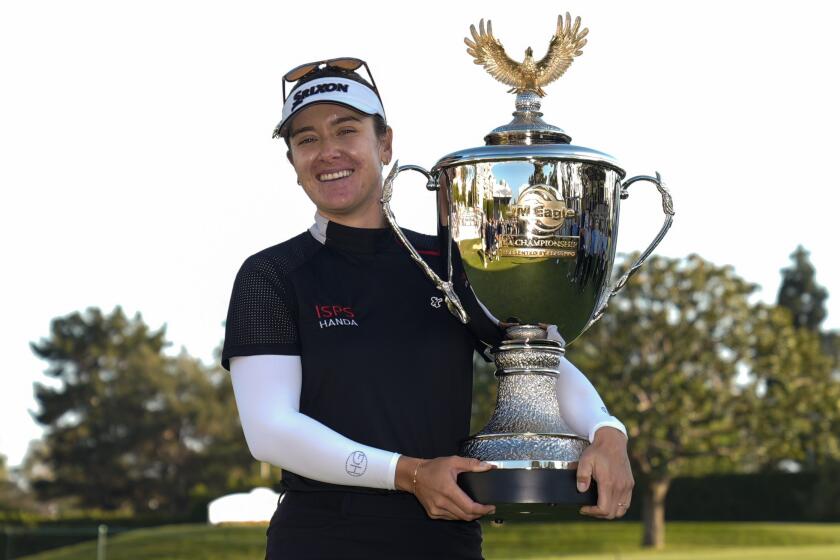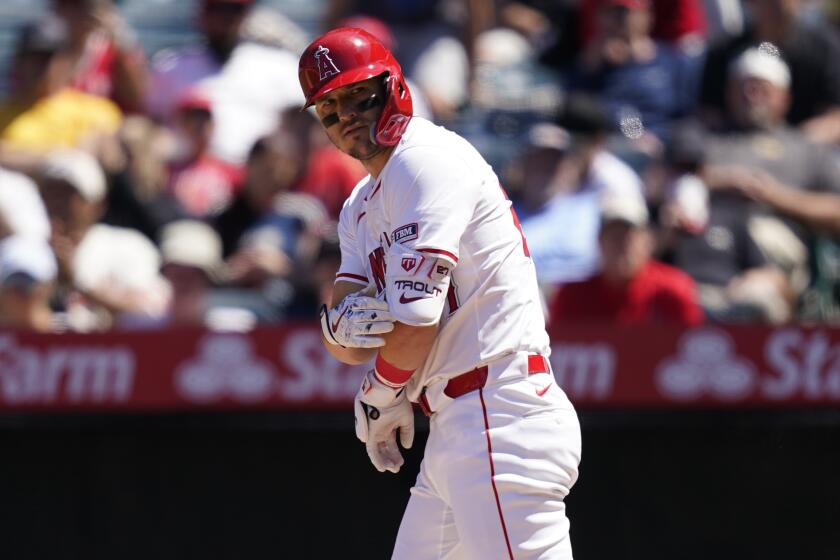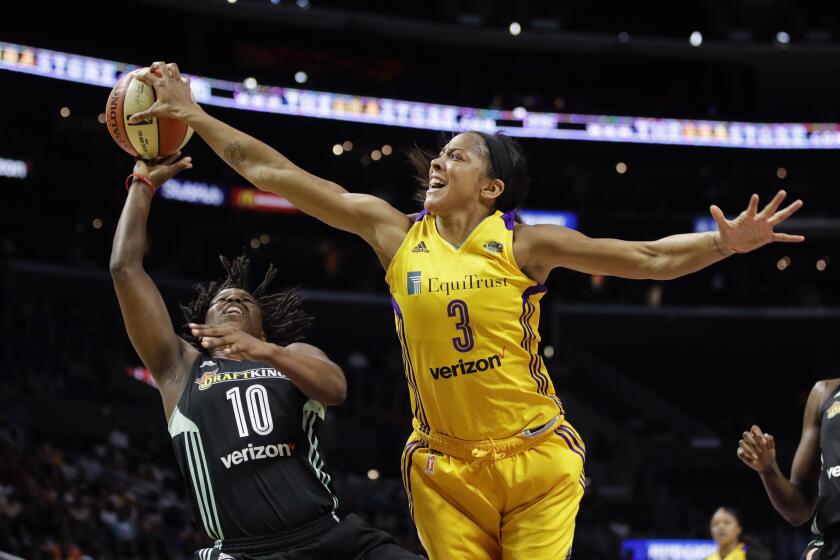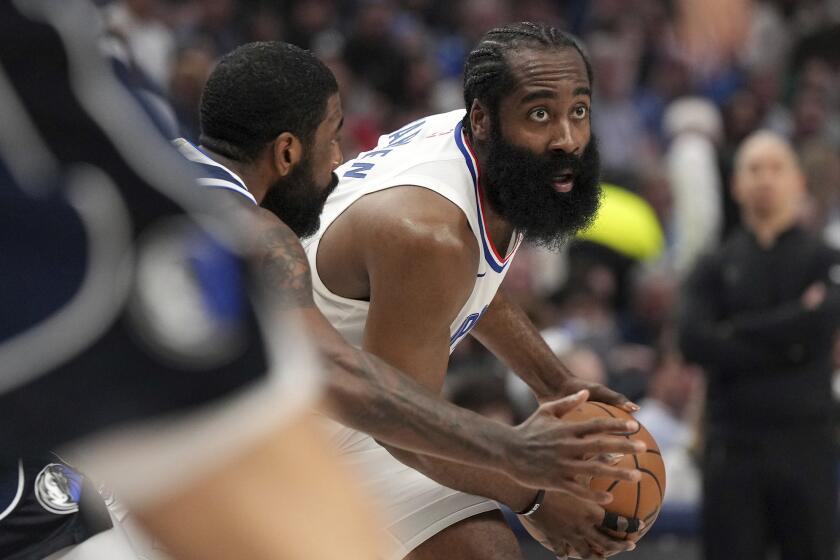Ball is now in ESPN’s court for the holidays
Games in the 76 Classic college basketball tournament will be played in front of thousands of empty seats at the Anaheim Convention Center today through Sunday, and the event organizers couldn’t care less.
They didn’t mind last week, either, when only a few thousand spectators dotted a 19,000-seat arena in Puerto Rico for another of their tournaments.
Filling seats isn’t a top priority for ESPN, extra programming is -- with the ultimate goal being to drive ratings by producing plenty of interesting early-season matchups between ranked teams.
“We had a planning meeting with the ESPN people Monday,” said Rob Halvaks, senior associate commissioner of the Big West Conference, which is providing the cable television technical support for its Anaheim tournament, “and ticket sales weren’t even on the agenda.”
This will be the second year that Anaheim has hosted the event, which features ranked teams in No. 14 Arizona State and No. 19 Wake Forest, plus Baylor, St. Mary’s, Providence, Charlotte, Texas El Paso and Cal State Fullerton -- all programs which have produced NCAA tournament teams in recent seasons.
The network last year spotlighted USC and marquee freshman O.J. Mayo in Anaheim, and this year all 12 games can be viewed on one ESPN station or another.
ESPN has created four holiday tournaments, and the fields are strong because the colleges all want national TV exposure.
Mike Bobinski, athletic director at Xavier, which last week defeated national runner-up Memphis in the title game of ESPN’s Puerto Rico Tip-Off, said the benefits of playing in such an event go beyond the financial -- top teams can get guarantees of more than six figures just to show up.
“I think the ESPN college guys took away tidbits about our team that they will use on broadcasts all year,” Bobinski said. “That has to benefit us.”
It works for ESPN too, which is why the network has plans to add a fifth event next year in Hawaii around Christmas.
The proliferation of such showcase tournaments started in 2006, after an NCAA rule change allowing teams to play in more than one “exempt event” every four years.
In an exempt tournament, a team was allowed to play up to four games at a neutral site with it counting only as one game on the schedule. Starting back in the 1960s, Hawaii and Alaska were the only places allowed to host exempt tournaments, with the idea being that those far-flung locales needed help attracting quality mainland competition for their teams.
So, around Thanksgiving, college fans would sit back and watch teams such as UCLA, North Carolina and Kentucky play in the Great Alaska Shootout, then settle in again around Christmas and watch a similar field go at it in the Rainbow Classic in Honolulu.
“It was a great experience,” said USC’s Tim Floyd, who took the Trojans to Alaska in 2006, his first year as coach. “The kids had dinner with local families, there was snow, it was almost as good as going to a foreign country. I’ll take a team back again.”
Or maybe not.
This year’s Alaska tournament began Wednesday with a field of traditional host Alaska Anchorage, Hampton, Louisiana Tech, Northern Illinois, Portland State, San Diego State, Seattle and Western Carolina -- “So much less than before,” said Steve Cobb, Alaska Anchorage’s athletic director.
For example, past winners of that tournament include UCLA, Duke, Kentucky, North Carolina, Arizona, Cincinnati and Marquette.
“I think what happened in 2006 was a law of unintended consequence,” Cobb said. “The rule change wasn’t meant to empower ESPN, the 600-pound gorilla, but that’s what happened.
“ESPN creates events. ESPN can write a check to bring in some little guys like Presbyterian or Prairie View for the big guys to feast on early and then set up great matchups. We used to be televised by ESPN. All of a sudden the vendor becomes the competitor and I’m afraid the writing is on the wall for us.”
Cobb said the most his tournament can guarantee a team is $30,000, while he said he understood Memphis got more than six figures to play in Puerto Rico.
“Our tournament stood on the idea that teams would get to see Alaska,” Cobb said. “We paired them up with local family hosts who would feed them dinner. We give each team a high school band and cheerleaders. It’s a unique experience. But unique isn’t going to cut it up against ESPN.”
This year’s Alaska tournament is televised in . . . Alaska, though Cobb said he thinks a Fox Sports Pacific Northwest outlet might carry some games.
Cobb found a $200,000 sponsor in Carr/Safeway and still expects his arena to be close to filled this year. “But going forward, I just don’t know,” he said.
Now that it is in the tournament business, ESPN created a division called ESPN Regional television based in Charlotte, N.C.
Clint Overby, senior director of event management for that arm of ESPN, has more than just money at his disposal to draw the teams his group wants. It also uses the power of the Walt Disney Co., which owns ESPN, to secure quality playing facilities around desirable vacation locations.
For example, teams in Anaheim will have a special evening at Disney’s California Adventure, right across the street from the Convention Center. There’s also the Old Spice Classic at the Milk House near Disney World in Orlando that begins today featuring Georgetown, Gonzaga, Michigan State and Maryland.
“We want to provide teams with quality facilities, we want to offer traveling parties unique experiences and we want great national television matchups,” Overby said.
And if the games are played in relatively empty arenas, so be it. The point is to produce a basketball tournament as a great television show.
--
More to Read
Get our high school sports newsletter
Prep Rally is devoted to the SoCal high school sports experience, bringing you scores, stories and a behind-the-scenes look at what makes prep sports so popular.
You may occasionally receive promotional content from the Los Angeles Times.

